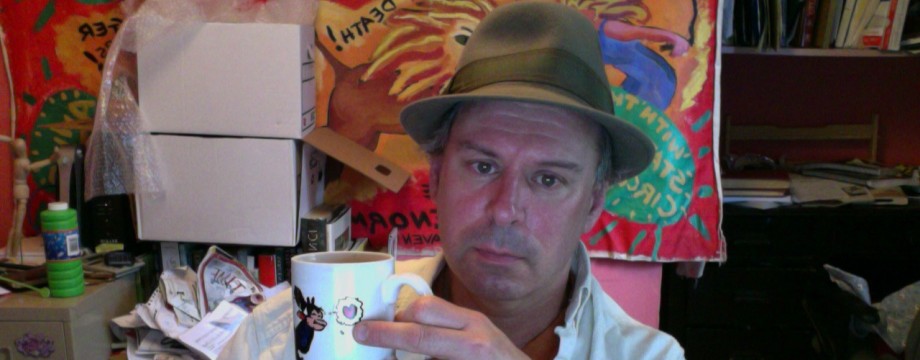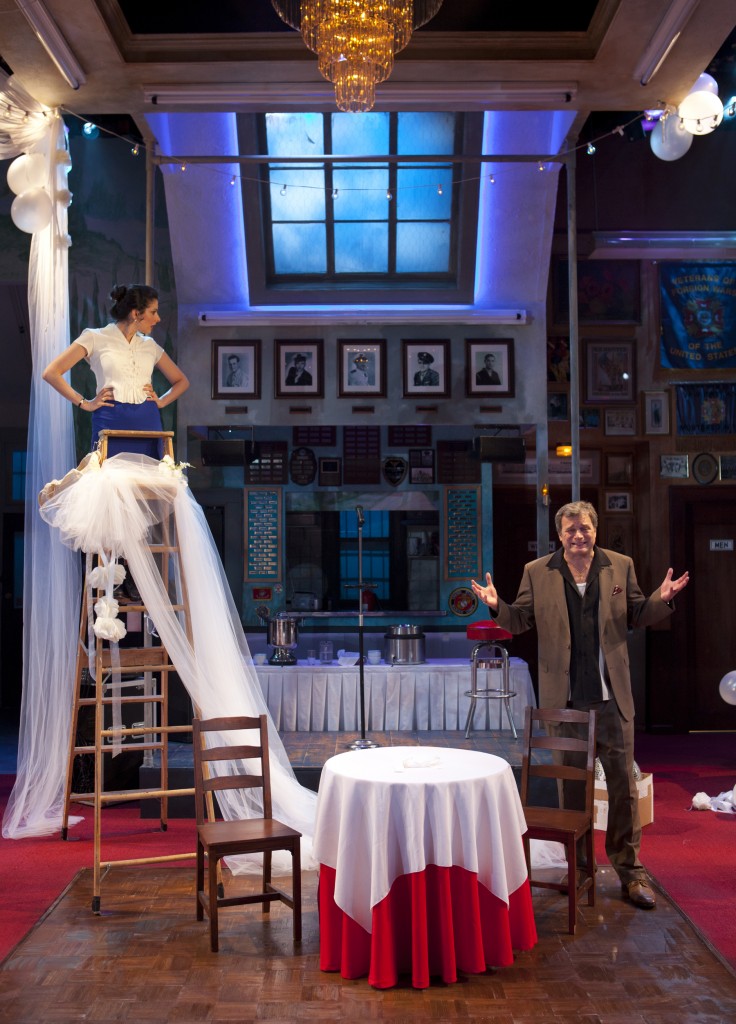Italian-American Reconciliation
By John Patrick Shanley. Directed by Eric Ting. Set design by Scott Bradley. Costume design by Lindo Cho. Lighting design by Russell Champa. Sound design by Sarah Pickett. Stage manager: Megan Scwarz Dickert. Performed by John Procaccino (Aldo), Lisa Birnbaum (Janice), Mike Crane (Huey), Stephanie DiMaggio (Teresa) and Socorro Santiago (Aunt May).
Through May 22 at the Long Wharf Theatre, New Haven.
Eric Ting knows how to build up a talky show’s other elements like nobody’s business.
Seems as if he takes the fleshing out of the physical parts of a loquacious play as a personal challenge. (Coming soon: Eric Ting directs the Telephone Directory!)
Ting did it with a couple of long-form monologues in the intimate Long Wharf Stage II, orchestrating dressing-up games for Bad Dates and having Mark Nelson dance between the drops from a leaky roof in Underneath the Lintel. On the mainstage, he went even grander with the water effects for the stage version of Toni Morrison’s The Bluest Eye, and also played up the youthful child’s-play aspects of the piece. Ting had a co-scripting hand in another mainstage lit adaptation— Hemingway’s The Old Man and the Sea—which was enlivened with an onstage musician. Most recently, he fused the new play Agnes Under the Big Top (the script of which lurches from long monologues to long periods of silent reflection) with the sounds of shadows of a subway tunnel.
Even a relatively straightforward production like last season’s rendition of A.R. Gurney’s Sylvia—Ting’s previous go-round with the star of Italian-American Reconciliation, John Procaccino—used the Long Wharf’s thrust stage cleverly to add three dimensions (grander entrances, intriguing spatial relationships) to what is often a one-dimensional comedy.
The wonder of Italian-American Reconciliation isn’t that Ting and his cast create a full-blown realistic environment to enhance John Patrick Shanley’s longwinded, often philosophical comedy. The clever part is that they only create part of that environment, and creative theatrical problem-solving fills in the rest.
The play’s setting is New York’s Little Italy in the 1970s. This production’s setting is a VFW banquet hall where a wedding has just been held, such a timeless setting that this play could be happening anytime in the last 40 years. The cast initially emerge as part of this fresh environmental staging concept: Procaccino (play Aldo Scalicki, the narrator of this dramatic comedy) is the wedding guest who won’t leave the hall, staying on to spin yarns and polish off a few extra glasses of wine. Socorro Santiago (Aunt May) is shown working in the kitchen. Huey Bonfigilano (the romantic lead, played by Mike Crane) is a busboy. Stephanie DiMaggio (Teresa) has an accordion in her hands.
The acclimation to this Italian dining hall starts while audience members are still finding their seats. On opening night, Procaccino held a long, silent, across-the-room conversation-of-gestures with Long Wharf artistic director Gordon Edelstein (seated midway back in section D of the auditorium).
Procaccino is also charged with delivering the pre-show “in case of emergency” and “turn off your phones” speeches. By the time he gets to the show’s conceit that he’s here to share a story and a life lesson with you, he’s an old friend. When he announces proudly that his mother’s in the audience—a point where the pre-show improvisation has ceased and Shanley’s intricately woven script has taken over—the audience completely buys into it, and applauds with sincerity.
From there, the production proceeds as if Procaccino’s genial guy (he’s working his Art Carney side again here, as he did on the same Long Wharf mainstage in Dario Fo’s We Won’t Pay! We Won’t Pay! in 2004) and the kitchen staff were supernaturally stirred to stage a romantic tale of love lost and regained, using whatever’s available—a staple gun for a zipgun, a stepladder for a balcony. It comes off as a realer-world Fantasticks, with a downtrodden troupe pulling into a desolate spot and performing their love story because they just must. The concept doesn’t hold up to deep scrutiny, since special effects do start flying after a while, and the relationships of the kitchen characters run the risk of skewing those of the romance’s characters. But what might not fly dramaturgically is nonetheless brilliant as an involving and disarming environmental device.
What such a staging really emphasizes is Shanley’s deft ear for characters who feel trapped by their families, their upbringings and their jobs. The fear of breaking with convention, going against the status quo, and doing what one is aching to do is the common element in such disparate Shanley works as Doubt, Joe vs. the Volcano, and this.
Building up the cultural environment beyond Shanley’s articulated accented spats and rants is the same impulse that Norman Jewison used when he directed Moonstruck, Shanley’s remarkably similar screenplay about Little Italy written around the same time as Italian-American Reconciliation. When Jewison wanted to surround Moonstruck story in Italian-American culture, he simply had to film the streets of New York, and an opera at the Met. The Long Wharf accomplishes the same immersion by adding as many personal interactions and background crises as possible. Shirts are stained with wine. There’s a fire in the kitchen. There’s endless clean-up work to be done. All in the service of subtextualizing and extending the human nature, psychological nuances and cultural signifiers of Shanley’s script.
There are many smart small details in this production, so many of them that you begin to admire the fact that they don’t detract from the main plot. Huey wants to get back together with his ex-wife Janice. To do so would obviously ruin his relationship with his sweet current girlfriend Teresa. Aldo, is at first incredulous but plucks up courage to help his lifelong friend out of sheer dumb loyalty.
This is a mythic construct which mirrors the Archie/Betty/Veronica/Jughead love quadrangle in comic books I’ve personally been devoted to all my life. The scenario transfers smoothly to the stage. Janice, the ball-busting beauty, is given a sensational second-act entrance, but the real magic is in the pouting smirk and dagger glances of Lisa Birnbaum, who plays Janice as less of a bitch than as an attractive woman who’s had to lace herself up in so much protective armor that she’s smothering herself. As Teresa, Stephanie DiMaggio must turn on a dime emotionally, from head-over-heels in love to fighting mad to vulnerably and confused, and she does so believably. Socorro Santiago takes a comic-relief oputspoken-wise-old-woman role and adds a jolt of world-weariness that amplifies how reckless the other characters’ bouts of energy can seem. Mike Crane, slight and wiry and always on edge, is a Huey Buonfigilano that you won’t necessarily root for but can definitely feel for.
All these characters—balancing their outpourings of sweat, blood and affection with the game artifice of playing out a love story with a VFW hall as a stage—are encompassed in the grander format of John Procaccino as Aldo Scalicki, setting that stage and storytelling its action, then gliding in and out of it as a character. The tone is an ensemble one, the setting ramped up a notch by the inventive set-pieces and sight-gags and environmental enhancements. But the pace is Proccacino’s, and he keeps it light and funny and cordial even when the mood threatens to turn dark and menacing.
For a show about manic relationships in a tight community, set in a large old hall after a wild wedding, this kitchen-sink comedy really cleans up.


One Response to The Italian-American Reconciliation Review